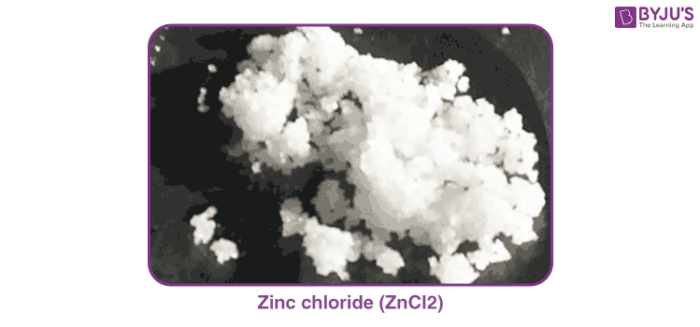What is Zinc Chloride?
Zinc chloride is a chemical compound with the formula ZnCl2.
Nine different crystalline forms of zinc chloride are currently known. These hydrates of ZnCl2 are either white in colour or colourless. All of them are highly soluble in water.
Table of Contents
- Zinc Chloride Structure
- Zinc Chloride Preparation
- Properties of Zinc Chloride
- Uses of Zinc Chloride
- Frequently Asked Questions – FAQs
Zinc chloride exhibits hygroscopic qualities, i.e. it attracts and captures the water molecules from the environment. Therefore it is very essential to protect zinc chloride from moisture.

The five known hydrates of zinc chloride have the general formula ZnCl2(H2O)n where the values of n can be 1, 1.5, 2.5, 3, and 4. Solid ZnCl2 exhibits polymorphism and can take on one of the following crystal structures: tetragonal, monoclinic, and orthorhombic.
Zinc Chloride Structure
Zinc chloride is an inorganic binary salt. A molecule of zinc chloride features ionic bonding between the zinc cation (Zn2+) and the chloride anions (Cl–). The structure of a ZnCl2 molecule is illustrated below.

Structure of Zinc Chloride Molecules
It is important to note that the zinc-chlorine bond in ZnCl2 possesses some covalent characteristics, which accounts for its low melting point and its solubility in ethereal solvents.
Zinc Chloride Preparation
The reaction between metallic zinc and hydrogen chloride gas yields an anhydrous form of zinc chloride. The chemical equation for this reaction is given by:
Zn + 2HCl → ZnCl2 + H2
In order to obtain a hydrated form of the compound, hydrochloric acid can be used to treat zinc instead of hydrogen chloride. Hydrochloric acid reacts with zinc sulphide to form zinc chloride and hydrogen sulphide. The chemical equation for this reaction is given by:
ZnS + 2HCl → ZnCl2 + H2S
Since the only oxidation state exhibited by zinc is +2, the purification of the product is relatively simple.
Properties of Zinc Chloride
Chemical Data
| Zinc Chloride | ZnCl2 |
| Molar Mass | 136.315 grams per mole |
| Density | 2.907 grams per cubic centimetre |
| Melting Point | 563 K (290oC) |
| Boiling Point | 1005 K (732oC) |
Physical Properties of Zinc chloride
- Zinc chloride is solid at room temperature and has a white crystalline appearance. It is odourless.
- The solubility of this compound in water corresponds to 432g/100g. It is also soluble in acetone, ethanol, and glycerol.
- The four polymorphs of ZnCl2 feature a tetrahedral coordinate geometry between the Zn2+ ions and the Cl–
- Molten zinc chloride is highly viscous and has a relatively low electrical conductivity value.
Chemical Properties of Zinc chloride
- When ZnCl2 is dissolved in water, the resulting solution is acidic in nature. The pH of an aqueous solution of zinc chloride with a concentration of 6M is 1.
- This compound reacts with ammonia to form complexes. Examples include Zn(NH3)4Cl2 and ZnCl2(NH3)2.
- When heated, the hydrated form of zinc chloride loses water and small quantities of ZnCl(OH) are obtained.
- The chemical equation for this reaction is given by: ZnCl2.2H2O → ZnCl(OH) + H2O + HCl
What are the Uses of Zinc Chloride?
Since it reacts with metal oxides to yield compounds with the general formula MZnOCl2 (Where M is the metal), zinc chloride is used as a flux/cleaning agent for soldering purposes. These fluxes have the ability to dissolve the layer of oxides on the surface of the metal. Some other uses of this compound are listed below.
- In its molten state, this compound acts as a catalyst for some aromatization reactions. For example, hexamethyl benzene can be obtained from methanol with the help of a molten ZnCl2
- Since it acts as a moderately strong Lewis acid, this compound can also serve as a catalyst for the Fischer indole synthesis reaction and some Friedel-Crafts acylation reactions.
- The Lucas reagent is a solution of anhydrous zinc chloride and concentrated hydrochloric acid. This reagent is very useful in the preparation of alkyl chlorides.
- A mixture of zinc oxide and hexachloroethane is used in some smoke grenades. Upon ignition, these compounds react to form a smoke of zinc chloride, which serves as a smokescreen.
- ZnCl2 is also useful in fingerprint detection since it forms an easily detectable complex with Ruhemann’s purple.
- The aqueous solutions of this compound, when diluted, can be used for disinfecting purposes. It is a constituent of several antiseptic mouthwash products.
Frequently Asked Questions – FAQs
What are the uses of zinc chloride?
As it reacts with metal oxides to produce compounds using the general formula MZnOCl2 (where M is the metal), zinc chloride is used as a soldering flux/cleaning agent. Such fluxes are capable of dissolving the oxide layer on the metal surface.
Is zinc chloride safe for consumption?
Zinc chloride is highly corrosive if ingested and is also a strong irritant if inhaled. Zinc chloride is extremely corrosive and ingestion of even 10 mL of a 35 % solution can result in oropharyngeal and gastric burns, epigastric tenderness, pharyngeal oedema, haematemesis and melaena.
Is zinc chloride ionic or covalent?
Zinc chloride is an ionic compound. The cation in this compound is zinc and the anion in this compound is chlorine. But it has some covalent characters too
Is zinc chloride a reducing agent?
The zinc causes the sulfur to gain electrons and become reduced. So zinc is called the reducing agent. The oxidizing agent is a substance that causes oxidation by accepting electrons. The reducing agent is a substance that causes reduction by losing electrons.
What is zinc chloride used for?
Zinc chloride is used in dry cells as an electrolyte. It is used as a condensing agent, disinfecting purposes, dehydrating agent, wood preservative, deodorant, and disinfectant.
To learn more about zinc chloride and other chemical compounds containing zinc, such as zinc sulfate, register with BYJU’S and download the mobile application on your smartphone.

Comments